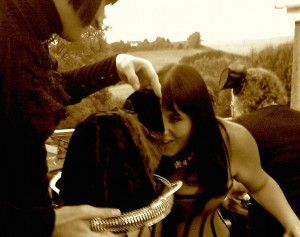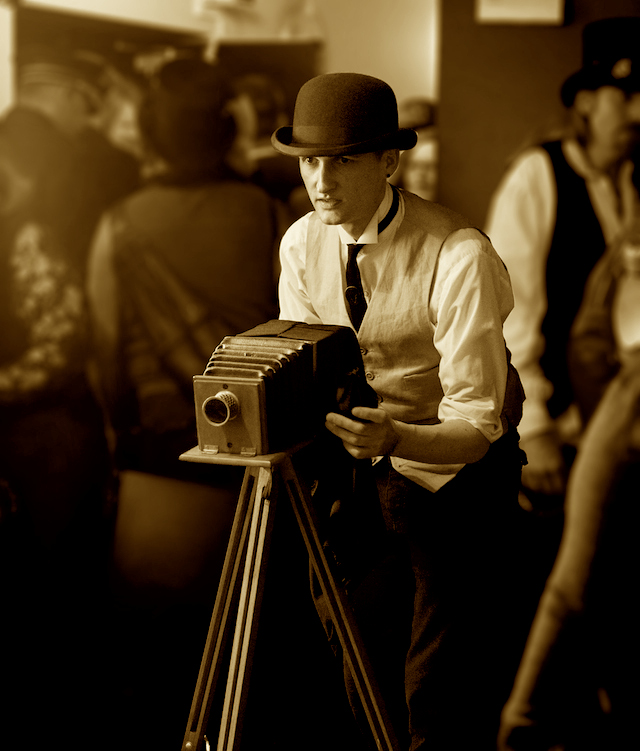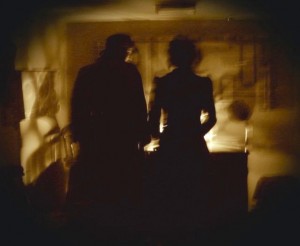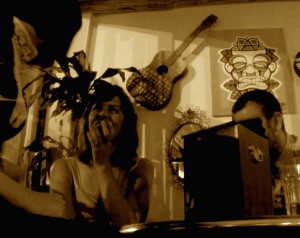BY SIMON LOCK
The term Steampunk emerged in the 1980s as a classification for a branch of fictional literature and film. It imagines a modern world, but with knowledge, skills and materials as they were during the late Victorian era. The “steam” element of the name is due to the preoccupation with steam engines as the main source of power. The “punk” part derives from its similarities with and relationships to the cyber-punk genre of fiction.
Since the term was originally coined, it has been adopted by an emerging craft and lifestyle movement, the participants in which share a common set of ideals and aesthetics. This includes the love of ‘authentic’ materials (such as wood, brass, leather, etc.) and an emphasis on DIY, tinkering and mastery of technology.
Members of this movement participate in real-world groups and events such as Steampunk festivals like Crewe Convivial and nightclubs like White Mischief, as well as finding a place within academia with publications such as the Journal of Neo-Victorian Studies.
We at Bottlejack and Hastener make use of Steampunk in the creation of digital artwork (including such things as interactive gallery installations and computer-mediated performance).
In our approach to Participatory Design (PD), we are interested in how the technological “time-shifting” and anachronism can be exploited as a fantasy interventional strategy to engage audiences and help unleash creative design possibilities. By using the aesthetics and ideals of Steampunk, participants are freed to indulge in fantasy imaginings of possible behaviours and hypothetical activities.
PD has been around for many years and has been extensively used in the development of interactive systems. Its main aim is to involve users (or audience members) in the design process, helping designers to gain an empathetic understanding of their needs and desires.
As Bottlejack and Hastener, we use various performative strategies to engage members of the general public from real-world social contexts to participate in design and evaluation “workshops”. We focus particularly on what has been termed “playful arenas” such as themed nightclubs, cabaret events, festivals and fairs where role-play, fantasy performance and audience participation are all encouraged and embraced. In so doing we tap into a resource of potential participants with a wealth of existing performative skills and abilities.
 Most recently we have used these techniques to explore the act of Portrait Photography as a performative and aesthetic activity at public events (for example, at the recent Exeter Phoenix Steampunk Yule Ball. In particular, we focus on the iconic role of the photographer as enactor of numerous theatrical processes, aided by a rich and varied supporting cast of posing subjects, elaborate equipment, thematic props, scenery and other vintage paraphernalia.
Most recently we have used these techniques to explore the act of Portrait Photography as a performative and aesthetic activity at public events (for example, at the recent Exeter Phoenix Steampunk Yule Ball. In particular, we focus on the iconic role of the photographer as enactor of numerous theatrical processes, aided by a rich and varied supporting cast of posing subjects, elaborate equipment, thematic props, scenery and other vintage paraphernalia.
We are not alone in seeing the potential of performative approaches to Participatory Design. Aspects of role-playing have been used in PD approaches since the 1980s, with a various authors describing their experiences of using performance techniques. Kuutii et al, for example, advocates involving both designers and participant users as spectators and actors at the same time – what Boal refers to as “spect-actors”.
Sato and Salvador propose the concept of the “Focus Troupe”: focus groups, but with an additional performative twist. These are based around the usual focus group activities, but also make use of dramatic vignettes acted out by live performers. This helps to set the context for focus group discussions by introducing the new product or device concept that is being designed.
Similarly, Burns et al make use of an approach they call “Informance Design” (inform + performance), where actors present performances to an audience of around 30 designers in order to open up dialogue and discussion. These performances often involve improvisation around a prototype device and promote the development of key characters within its context of use.
 All of the above approaches offer a number of benefits to designers. Firstly, because they are enactive and experiential, they enable designers to better imagine the world of the user/audience and thus empathize more deeply with them. Secondly, the performances act as a focal point for discussion, improving communication between various stakeholders involved in the design process.
All of the above approaches offer a number of benefits to designers. Firstly, because they are enactive and experiential, they enable designers to better imagine the world of the user/audience and thus empathize more deeply with them. Secondly, the performances act as a focal point for discussion, improving communication between various stakeholders involved in the design process.
Our approach to Participatory Design in workshops is partly observational in that we document interesting and intriguing occurrences as they arise. Unlike purely observational approaches however (such as many forms of ethnography) we aim to proactively intervene and disrupt in order to gain additional insight and explore new ideas.
In the portrait photography example mentioned earlier, we use this approach to explore and develop various aspects of the experience, including:
- Communicative interaction between the various participants involved (photographer, subjects, by-standers)
- Exaggerated positioning of the camera and various other pieces of photographic equipment
- Pivotal capturing of the photograph – the actual “pressing the button” (or squeezing the bulb)
- Discussion of resulting images (and optional retaking of imperfect images)
- Post-event processing, developing (and even delivery) of the final images
During design workshops, evidence is gathered primarily from feedback received from the audience. Conversations made possible by direct contact with audience members permit a type of informal interview to take place. Comments, quotes, themes and trends emerging from these discussions provide an invaluable repository of evidence for the purposes of review and evaluation.
Personal observations made by the enactors also provide a wealth of additional data. By reflecting on their own experiences, the enactors can themselves provide a valuable source of evidence to support evaluation and refinement. All of these fragments of evidence can be documented in a variety of different ways, including audio and video recordings, written transcripts, the taking of “live” notes, post-event chronicles and photo records of contexts and interactions.
The use of an anachronistic element promotes creativity and helps to release design from the shackles and constraints of well-worn paths and comfortable, familiar solutions. In the case of the Portrait Photographer example, we have been able to develop the work over a number of events from an initially relatively simple activity into an elaborate extended experience.
We have found that Anachronistic Intervention provides a useful tool for participatory design and iterative prototyping of digital interactive artwork and experiences. The novelty of the approach provides an appealing lure by which we can engage and involve members of the general public in insightful role-play.

About the author:
Dr Simon Lock is Lecturer in Digital Arts and Technology at Plymouth University. He is a member of i-DAT, an Open Research Lab for playful experimentation with creative technology.




